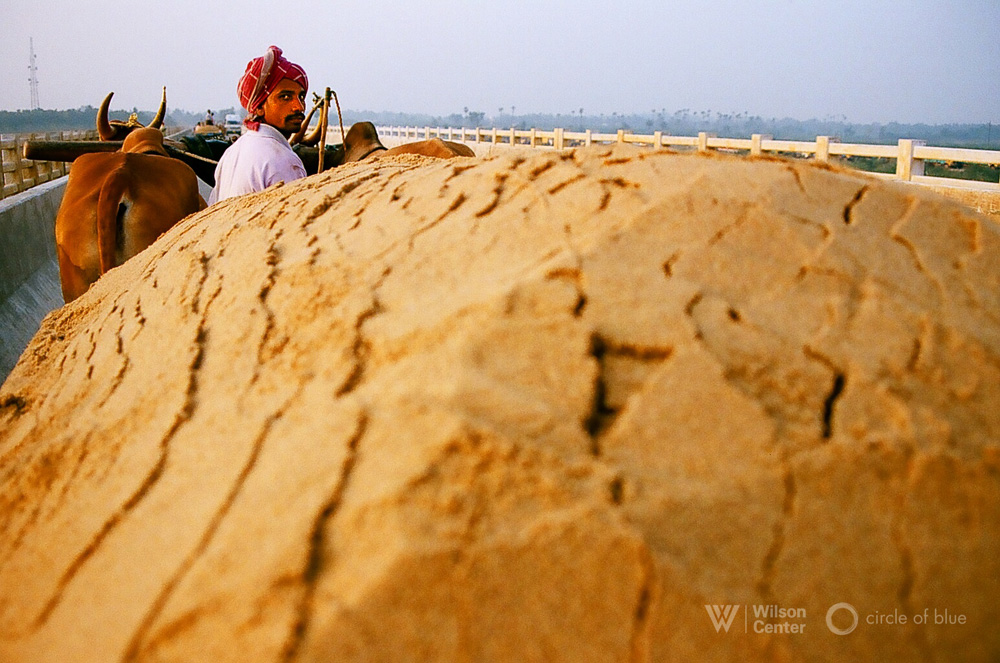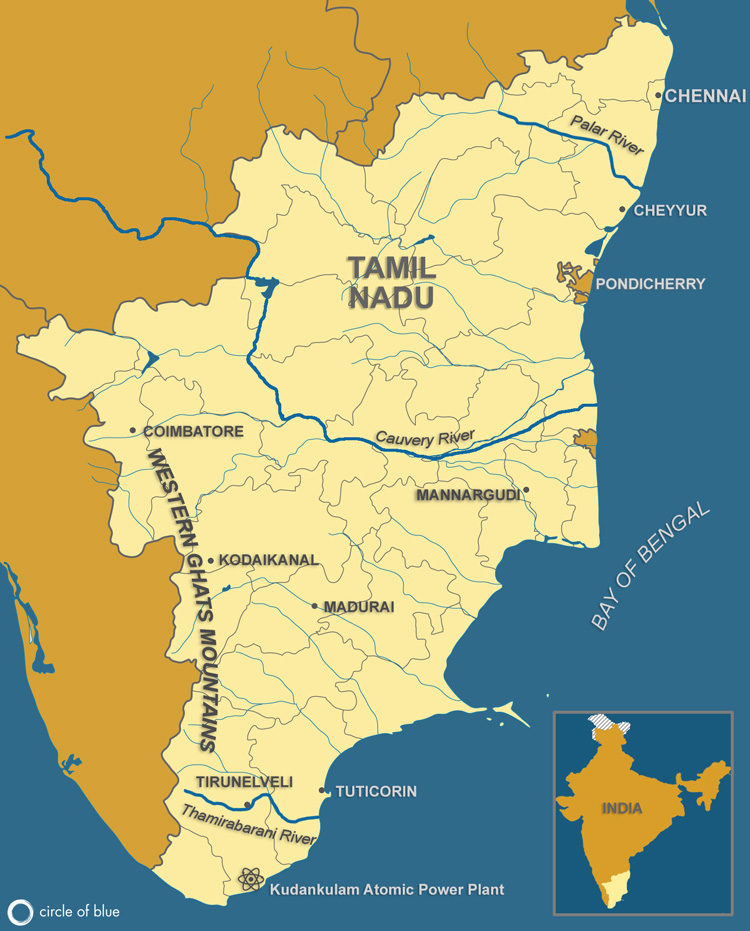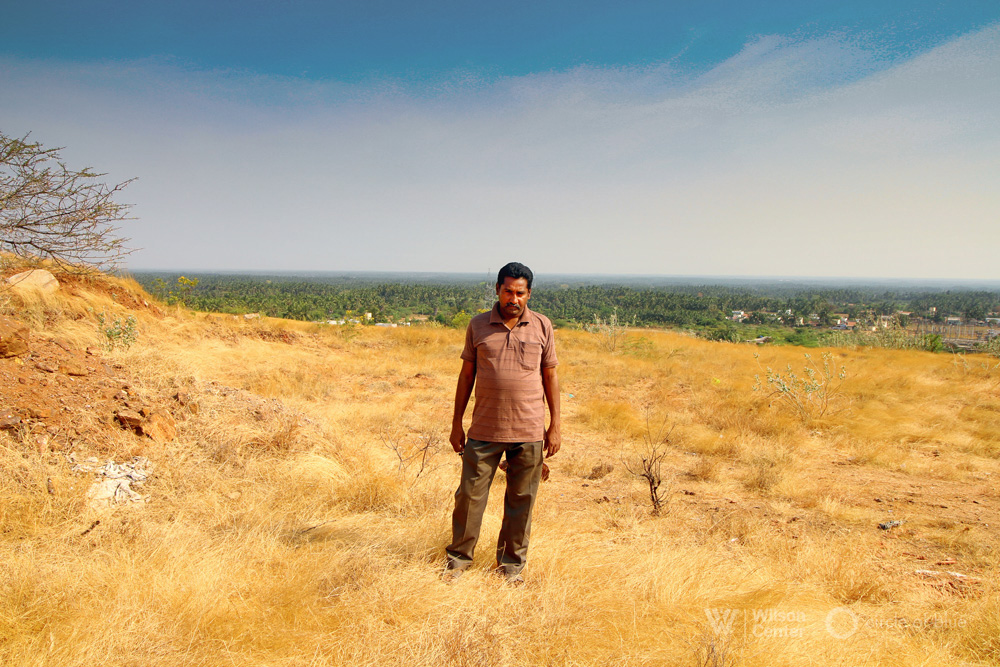-
Miners Plunder Tamil Nadu’s Sands, Dropping Some Rivers by 50 Feet
May 24, 2017 By Sibi ArasuCHENNIMALAI, India – There is river and beach sand aplenty in Tamil Nadu. At 130,000 square kilometers (50,200 square miles), the state is about the same size as Nicaragua and has 95 rivers with sandy bottoms and a long Bay of Bengal shoreline. Or did. For almost all of its thousand-year history, the state of Tamil Nadu took all that sand for granted. No longer.
India’s construction boom, which this year is projected to generate $165 billion of India’s $2.5 trillion gross domestic product, is largely built on concrete that requires millions of tons of sand. Various estimates by universities and media groups find that sand mining is now a 500 million-metric-ton-per-year industry that employs 35 million people and could generate over $50 billion a year in revenue.
Those same investigators assert that much of India’s sand is extracted illegally by miners who not only defy national regulators and court orders, but also intimidate and sometimes murder their critics.
“They grabbed my throat and asked me to leave Karur and never come back”Among the industry’s many targets is 50-year-old S Mugilan, a grassroots activist who colleagues say is a study in courage. He works with a loose coalition of activists and community members that changes with each campaign, traveling across the state to help organize communities affected by industrial and environmental problems.
The latest attack came in mid-December 2016, while driving back at night from a public meeting against the plundering of sand from the Cauvery River near the town of Karur with a colleague and his three children. A truck all of a sudden blocked a bend in the road and a dozen hired thugs fell on the car. “Managing to open the door, they pulled me out legs first but I clung on desperately,” Mugilan said in an interview. “They grabbed my throat and asked me to leave Karur and never come back. Even though it lasted for only about 10 minutes, they managed to hurt me pretty badly. The locals, seeing us being attacked, rushed to the car and the thugs dispersed. The children were traumatized.”
Later that night, Mugilan visited the home of the district magistrate and requested a case of criminal assault be registered. He held a dharna – a sit-in – for hours. The next morning he learned that a counter-charge had been registered instead, alleging that Mugilan and his companions were the perpetrators of the violence.
“This is what usually happens,” he said. “It’s just another day in the life of anyone like me, who the powers-that-be are afraid of. At least now we know that we are making a real impact here.”
An Industry Gone Rampant
Mugilan’s work, and that of a small group of other mining opponents, is aimed at one outcome: protecting Tamil Nadu’s dwindling rivers, aquifers, and beaches.
The Tamil government estimates that between 5,500 and 6,000 truckloads, each measuring of 200 cubic feet of sand, are mined in Tamil Nadu every day. But Mugilan puts the number much higher, at 90,000 truckloads or more. He also disputes the state’s assertion that the market rate for sand is $105 to $120 per truckload. The actual price, he says, is $300 to $600, and much more if it is trucked out of state.
 The potential for that kind of profit, which is substantial in the local economy, galvanizes miners. Sand mining on the Bay of Bengal shoreline is so rampant that entire stretches of beaches have disappeared. Just one case filed in the Madras High Court alleges that $14 billion worth of sand was illegally mined by a single mafia boss and his company over two decades.
The potential for that kind of profit, which is substantial in the local economy, galvanizes miners. Sand mining on the Bay of Bengal shoreline is so rampant that entire stretches of beaches have disappeared. Just one case filed in the Madras High Court alleges that $14 billion worth of sand was illegally mined by a single mafia boss and his company over two decades.Mining large amounts of sand causes significant erosion, which in turns affects bird and fish habitats. Sandy riverbeds also perform vital hydrological functions including absorbing floodwaters and allowing aquifers to refill. Because of aggressive mining, the bottoms of two of the state’s major rivers, the Thamirabarani and the Palar, have dropped 15 meters (50 feet) in some places during the past two decades, according to state measurements.
“The sad reality is that the mining stops only when the sand’s been completely extracted, so when the monsoons come along, there is no sand to retain water in the rivers and they flow straight to the sea, as if through a water hose,” said Mugilan. “The groundwater levels keep constantly dropping and the once glorious river systems, which were the lifeline for the state’s agriculture industry, are now in pathetic conditions.”
Orders From Above
India’s enforcement of natural resource protection statutes has for years been inconsistent and episodic. The country is often tremendously observant of the safety of its iconic wildlife. Several years ago in the northeast India state of Meghalaya, for instance, drivers transporting an elephant were arrested and jailed for inhumane treatment of the animal. The elephant was improperly bound in the truck bed with chains.
But many central and state governments allow cities and industry to wantonly pollute the nation’s rivers, which are among the world’s filthiest. Sand mining opponents often assert that government agencies do not want to shut down sand mines and are complicit in their operation. “For every truckload of sand that is mined, legal or illegal, we estimate that 200 rupees [$3] goes to a close aide of the state’s chief minister,” Mugilan said.
In his 2014 book, Thathu Manal Kollai (“the stealing of beach sand”), Mugilan asserted that Tamil Nadu’s biggest miner of beach sand is a prominent industrialist named S. Vaikundarajan, chairman of VV Minerals, India’s leading exporter of industrial minerals. Vaikundarajan also owns a news channel, among other interests, and has close ties to ministers in the ruling All India Anna Dravida Munnetra Kazhagam party. In 2013, the industrialist’s name appeared in a state investigation of illegal sand mining worth $14.3 billion in southern Tamil Nadu’s Tuticorin district, according to The Times of India.
There are parts of the government that are fighting back. In 2012, the Indian Supreme Court directed states to subject sand mining to environmental assessments before issuing permits. The court, in its ruling, remarked that “sand mining on either side of the rivers, upstream and in-stream, is one of the causes for environmental degradation and also a threat to the biodiversity. Over the years, India’s rivers and riparian ecology have been badly affected by the alarming rate of unrestricted sand mining.”
The National Green Tribunal, another high Indian court that reviews environmental cases, shut down a number of sand mines in 2013 that had not conducted assessments. Many of the cases were brought by the NGT Bar Association, a group of environmental lawyers which contended that “rampant illegal mining and transport of thousands of tons of sand is being carried on every year and is causing a loss of hundreds of millions of rupees” to government accounts.
In December, Tamil authorities also arrested Shekhar Reddy, a mining baron, and several associates in the mining business and removed Chief Secretary P. Rama Mohana Rao, a senior state government official, accusing the men of being “sand mining mafia.” The Central Bureau of Investigation said it recovered large amounts of cash and gold from Reddy’s home in Chennai.
Activists Face Death
Mugilan, who lives in a modest home in Chennimalai, a small town about 450 kilometers (280 miles) southwest of Chennai with his wife and son, says matter-of-factly that his work puts him in constant danger. He has been threatened many times, as well as arrested for sedition and jailed.
Others have been less fortunate. Although poorly documented, anecdotal accounts and scattered news reports indicate that numerous activists and government officials who have opposed sand mining have been injured or killed in Tamil Nadu.
“When the entire system is in their hands, it’s sometimes difficult to get the word out”A report in the progressive news magazine Frontline details some of these incidents. An 81-year-old retired teacher named Sam Devasagayam, who was campaigning against illegal sand mining in the Thamirabarani River, was hacked to death in 2014. The same year, a 43-year-old police constable named G Kanakaraj was run over by a truck carrying illicitly mined sand. And a government official and four colleagues narrowly escaped when a truck carrying sand rammed into their car. Two years earlier, 24-year-old Satheesh Kumar was killed by a speeding truck while standing guard against sand mining in the Nambiyar River.
“I can think of at least four government officials who have been killed because of their stringent positions against sand mining in the last decade or so,” said S. Amudhan, a sand mining activist, in an interview. “Most of the attacks are attributed to negligent driving or road accidents and the connections between their efforts to curb sand mining and their deaths are hardly ever laid out.”
Mugilan said he knows of at least 20 people, including activists, villagers, and government officials, who have lost their lives over illegal sand and granite mining (another construction-related sector), and countless others who have been injured. “These deaths are seldom reported in the media since the regional journalists too are targeted if they are to report on these incidents. When the entire system is in their hands, it’s sometimes difficult to get the word out,” he said.
Mugilan has gotten used to the threats and claims his family has too. “My wife now just says, ‘You can do what you want,’ whenever someone calls our home to threaten us,” he said. “Both she and my son accept that what we’re trying to do is important and goes beyond just our family.”
“When I was growing up, we could take the water right out of the Noyyal River and drink,” Mugilan said. “We used to play in the river for hours, spend so much time there. My son can never experience the same. Maybe through our efforts, we can bring the region back to how it was, or at least a semblance of it.
“People need to understand that natural resources are their common property; they have to protect them.”
The conflicting demand for water, food, and energy is one of the defining challenges of the 21st century. Global Choke Point, a collaboration between Circle of Blue and the Wilson Center, explores the peril and promise of this nexus with frontline reporting, data, and policy expertise. “Choke Point: Tamil Nadu” is supported by the U.S. Consulate General in Chennai. Jayshree Vencatesan of Care Earth Trust, Nityanand Jayaraman, and Amirtharaj Stephen provided expertise and invaluable guidance.
Sibi Arasu is an independent journalist based in Chennai. Follow him on Twitter @sibi123.
Sources: ABC, Economy Watch, Frontline, Reuters, SBS, Statistics Times, Supreme Court of India, The Times of India, Wired.
Photo Credits: Used with permission courtesy of Sibi Arasu.
 A Publication of the Stimson Center.
A Publication of the Stimson Center.








